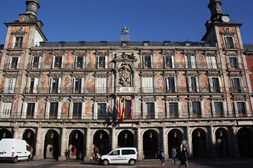The origin and functions of the Plazas Mayores
 The square as a meeting place, of celebration of religious and civil ceremonies and as a centre of social life of a city has been present in Western civilization since ancient times, whose first famous historical examples are found in the Agorá and the Greco-Roman forum. In the specific context of the Iberian Peninsula, squares were not an important factor in the city, built or remodeled from the Arab period, during which they conversely developed as an intricate network of streets and alleys. In the late Middle Ages, squares where not usually situated in the midst of mercantile civic areas, and indeed were often located outside the city walls. In 1480 an ordinance of the Catholic Monarchs insisted, for the first time, on the building of a plaza mayor in every city for the celebration of the market and as the place where the seat of municipal government, the ayuntamiento, would be located. In this way it became the seat of civil power. In the following centuries plazas mayores arose as spaces specifically designed for specific functions and were included in urban planning projects created by architects or maestros de obras (overseers of construction works). Without abandoning their role in the economic and political life of the city, the plaza mayor also became, in the Early Modern period, the theater where festive and religious ceremonies took place, such as bullfights, the autos de fe organized by the Tribunal of the Inquisition and public executions. To accommodate such events, the plaza mayor also gradually changed its appearance and took on new characteristics that made it look like an open-air theater: the creation of open porches, the greater height of buildings, the placement of balconies, broader and more regular forms, the progressive blocking of streets which gave access to it in order to obtain a closed and continuous space. The Ordenanzas de Descubrimiento y Población of Philip II, promulgated in 1573, established the imposition of the plaza mayor in the cities of the American colonies. In addition to a City Hall, the Spanish American plaza mayor also had to accommodate the main church, making of it, due to its vast size, as the true heart of the city.
The square as a meeting place, of celebration of religious and civil ceremonies and as a centre of social life of a city has been present in Western civilization since ancient times, whose first famous historical examples are found in the Agorá and the Greco-Roman forum. In the specific context of the Iberian Peninsula, squares were not an important factor in the city, built or remodeled from the Arab period, during which they conversely developed as an intricate network of streets and alleys. In the late Middle Ages, squares where not usually situated in the midst of mercantile civic areas, and indeed were often located outside the city walls. In 1480 an ordinance of the Catholic Monarchs insisted, for the first time, on the building of a plaza mayor in every city for the celebration of the market and as the place where the seat of municipal government, the ayuntamiento, would be located. In this way it became the seat of civil power. In the following centuries plazas mayores arose as spaces specifically designed for specific functions and were included in urban planning projects created by architects or maestros de obras (overseers of construction works). Without abandoning their role in the economic and political life of the city, the plaza mayor also became, in the Early Modern period, the theater where festive and religious ceremonies took place, such as bullfights, the autos de fe organized by the Tribunal of the Inquisition and public executions. To accommodate such events, the plaza mayor also gradually changed its appearance and took on new characteristics that made it look like an open-air theater: the creation of open porches, the greater height of buildings, the placement of balconies, broader and more regular forms, the progressive blocking of streets which gave access to it in order to obtain a closed and continuous space. The Ordenanzas de Descubrimiento y Población of Philip II, promulgated in 1573, established the imposition of the plaza mayor in the cities of the American colonies. In addition to a City Hall, the Spanish American plaza mayor also had to accommodate the main church, making of it, due to its vast size, as the true heart of the city.
